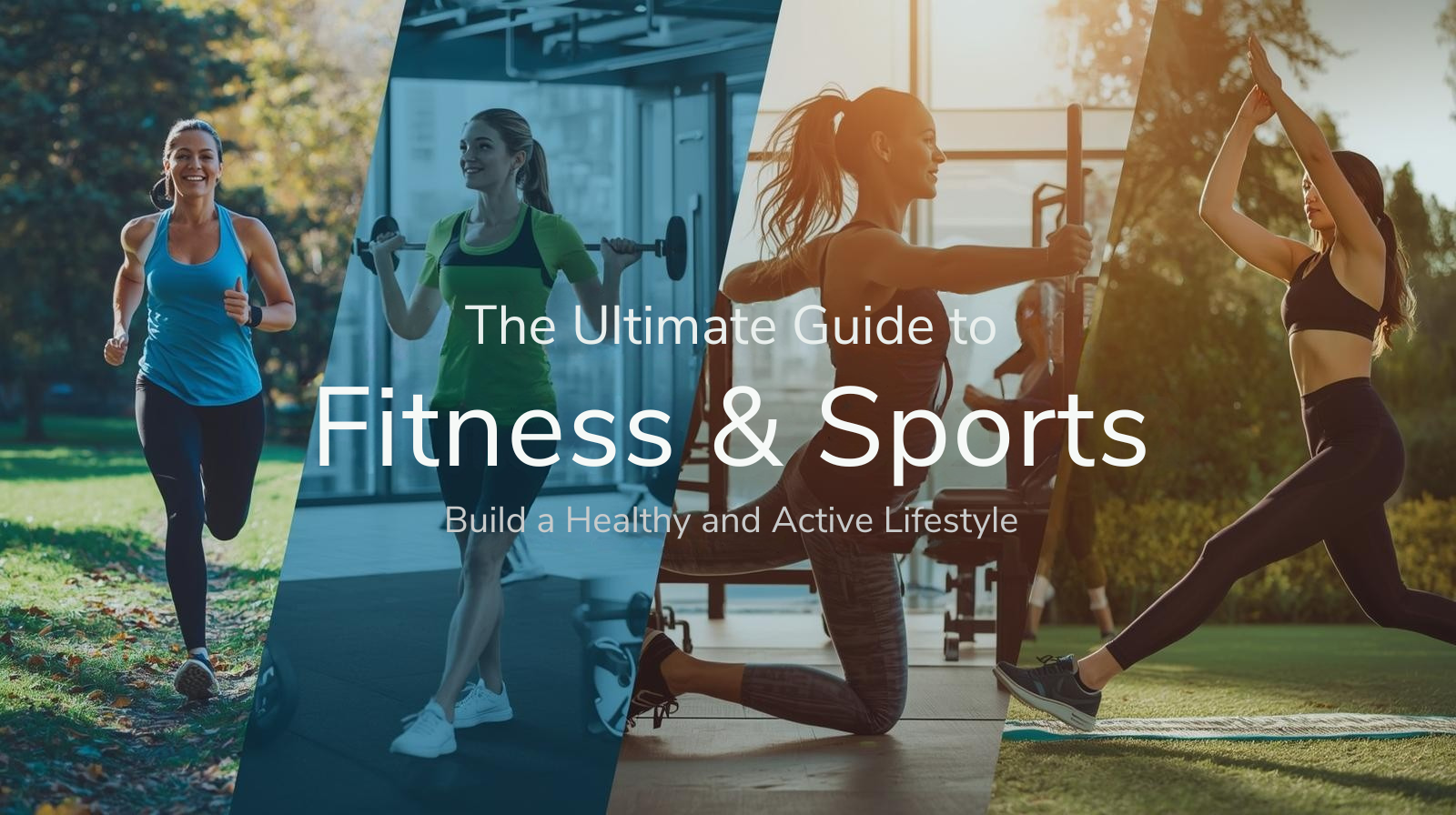Fitness and Sports
6 min read
The Ultimate Guide to Fitness & Sports: Build a Healthy and Active Lifestyle
October 27 , 2025
By Lillian Ashbaugh

Fitness and sports form the foundation of a strong and energetic lifestyle. People often underestimate their impact, but regular physical activity significantly improves physical health, mental well-being, and overall quality of life. Fitness is not only about aesthetics it strengthens your heart, muscles, and bones while boosting energy levels and endurance.
Sports complement fitness by teaching discipline, focus, teamwork, and resilience. Whether you play individually or in a team, sports challenge your body and mind, encouraging you to push boundaries and achieve your personal best. Together, fitness and sports cultivate a balanced, healthy, and fulfilling lifestyle.
The Benefits of Fitness
Physical Benefits
Fitness delivers countless physical advantages. Cardiovascular exercises, such as running or cycling, strengthen the heart, improve lung capacity, and enhance blood circulation. Strength training develops muscle mass, supports bone health, and improves posture. Flexibility exercises, including yoga and stretching, prevent injuries and maintain joint mobility.
Regular fitness routines lower the risk of chronic illnesses such as diabetes, obesity, and high blood pressure. Moreover, improved endurance enables you to perform daily tasks with ease, reducing fatigue and promoting long-term vitality.
Mental Benefits
Fitness also improves mental health. Exercise releases endorphins, the natural “feel-good” hormones that alleviate stress and anxiety. People who remain active enjoy better sleep, sharper focus, and heightened productivity.
Sports contribute to emotional growth as well. Athletes develop mental toughness, learn to handle pressure, and build resilience. Regular participation in sports enhances self-confidence and improves decision-making skills, both on and off the field.
Long-Term Health Advantages
Maintaining a fitness routine provides long-term benefits. People who exercise consistently experience lower risks of cardiovascular diseases, improved metabolism, and better weight management. Fitness also preserves muscle mass and bone strength as you age, supporting healthy aging and sustained independence.
The Role of Sports in a Healthy Lifestyle
Team Sports vs. Individual Sports
Team sports, such as football, basketball, and volleyball, teach collaboration, strategy, and communication. Players develop leadership skills while learning to support their teammates in high-pressure scenarios.
Individual sports, like tennis, swimming, or running, focus on self-discipline, personal growth, and mental resilience. Both types of sports enhance coordination, agility, and stamina while offering social engagement opportunities. The choice between team and individual sports depends on your personality, preferences, and fitness goals.
Discipline, Teamwork, and Mental Toughness
Participating in sports develops consistency, focus, and perseverance. Athletes train both their minds and bodies, learning to manage time, follow structured routines, and adapt to challenges. These skills are transferable to professional and personal life, improving your ability to handle stress, overcome obstacles, and maintain a positive mindset.
Popular Fitness Activities
Gym and Strength Training
Gym workouts target multiple muscle groups and enhance overall strength. Weightlifting, resistance exercises, and functional training improve muscle tone, metabolism, and body composition. Strength training also promotes better posture and reduces the risk of injuries by reinforcing muscles around joints.
Cardio Exercises
Cardiovascular exercises, including running, cycling, swimming, and rowing, improve endurance, stamina, and heart health. High-intensity interval training (HIIT) combines intense activity bursts with short rest periods, offering efficient fat-burning and enhanced fitness levels. Cardio routines also boost energy levels and mental clarity.
Yoga and Flexibility Training
Yoga enhances flexibility, balance, and core strength while reducing stress. Stretching exercises prevent injuries and maintain joint mobility. Practices like Pilates further improve posture, stability, and body awareness. Integrating flexibility exercises into your routine optimizes performance in other fitness activities.
Home Workouts
Home workouts provide convenience and flexibility, especially for busy lifestyles. Bodyweight exercises, including push-ups, squats, lunges, and planks, require no equipment. Resistance bands or dumbbells increase intensity and variety. Home routines promote discipline and allow consistent training regardless of access to a gym.
Popular Sports and Their Benefits
Football / Soccer
Football develops cardiovascular endurance, coordination, and agility. It also strengthens leg muscles and enhances reflexes. Players learn strategy, teamwork, and adaptability, improving both physical and mental skills.
Basketball
Basketball improves stamina, hand-eye coordination, and lower-body strength. The fast-paced nature of the sport encourages quick decision-making and enhances teamwork skills. Regular play increases cardiovascular health and supports weight management.
Tennis
Tennis requires speed, agility, and precise coordination. The sport strengthens muscles, improves flexibility, and sharpens focus. Tennis players develop strategic thinking and reflexes, making the sport excellent for both fitness and mental engagement.
Swimming
Swimming offers a full-body workout with minimal joint impact. It enhances cardiovascular endurance, muscle strength, and lung capacity. Swimming improves flexibility and coordination, making it ideal for individuals of all ages.
Running and Athletics
Running builds cardiovascular endurance and mental clarity. Long-distance running enhances stamina, while sprints improve explosive strength. Running also releases endorphins, promoting a positive mood and reducing stress.
Nutrition for Fitness and Sports Performance
Nutrition plays a vital role in performance and recovery. A balanced diet fuels workouts, builds muscle, and promotes energy.
Proteins: Essential for muscle repair and growth.
Carbohydrates: Provide energy for workouts and sports.
Healthy Fats: Support joint health and hormone balance.
Pre-workout meals supply energy, while post-workout meals support recovery and reduce muscle soreness. Staying hydrated is critical, as water regulates body temperature and optimizes performance.
Common Fitness and Sports Myths
“No pain, no gain”: Overtraining can cause injuries. Effective workouts challenge the body safely.
“Carbs are bad”: Complex carbohydrates provide essential energy for workouts.
“Strength training makes women bulky”: Women build toned muscles, not bulk, due to hormonal differences.
Understanding facts versus myths ensures smarter, safer fitness routines.
How to Start Your Fitness and Sports Journey
Set Goals
Define short-term and long-term objectives. Goals provide direction, motivation, and measurable milestones for progress.
Choose the Right Activities
Select activities that match your interests, fitness level, and lifestyle. Balance cardio, strength, and flexibility for a well-rounded routine.
Stay Consistent
Consistency is the key to long-term success. Track your progress, maintain discipline, and gradually increase intensity to see results.
Incorporating Fitness into Daily Life
Time Management Tips
Exercise in short intervals if schedules are tight.
Walk or cycle to work.
Use breaks for stretching or light activity.
Active Lifestyle Hacks
Take stairs instead of elevators.
Engage in recreational sports.
Incorporate movement into daily routines.
Small daily habits accumulate into significant long-term fitness improvements.
Technology in Fitness and Sports
Technology makes fitness accessible and measurable. Fitness apps track workouts, calories, and sleep, while wearables monitor heart rate and performance. Smart technology supports accountability, motivation, and data-driven improvements.
Conclusion
Fitness and sports offer a holistic approach to physical and mental well-being. By combining exercise, sports participation, balanced nutrition, and consistent routines, you can enjoy a healthier, more energetic, and fulfilling life.
Start small, stay consistent, and gradually increase intensity. Fitness is a journey, and sports make it enjoyable, social, and rewarding. Every step you take towards an active lifestyle strengthens your body, sharpens your mind, and improves your overall quality of life.
live smarter
Shop smarter, live better, and stay ahead of the trends with our reliable recommendations!

Gadgets and Tech
6 min read
2025's Top Smart Home Gadgets: Transform Your House into a Connected Haven
trending
Fitness and Sports
7 min read





